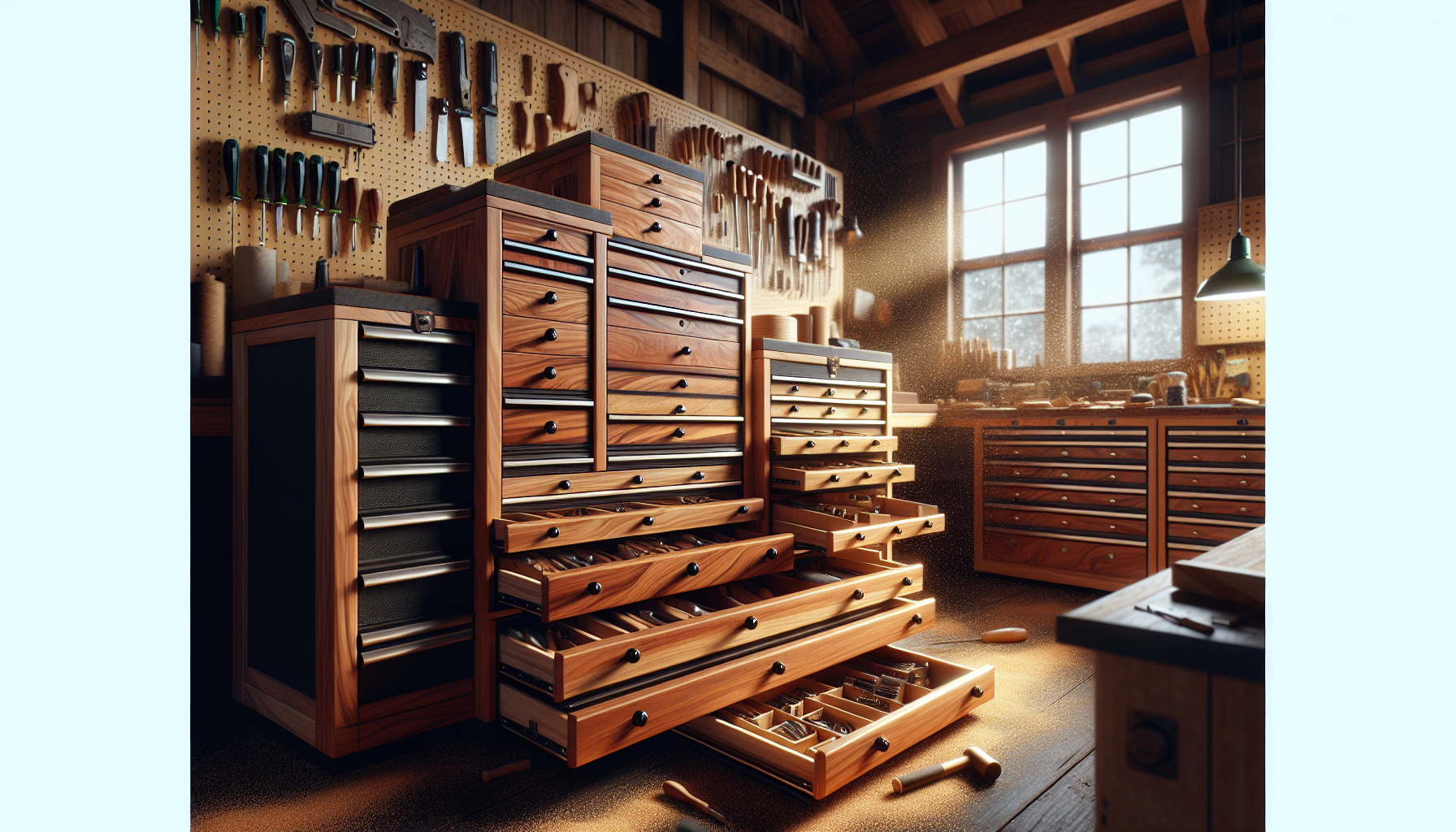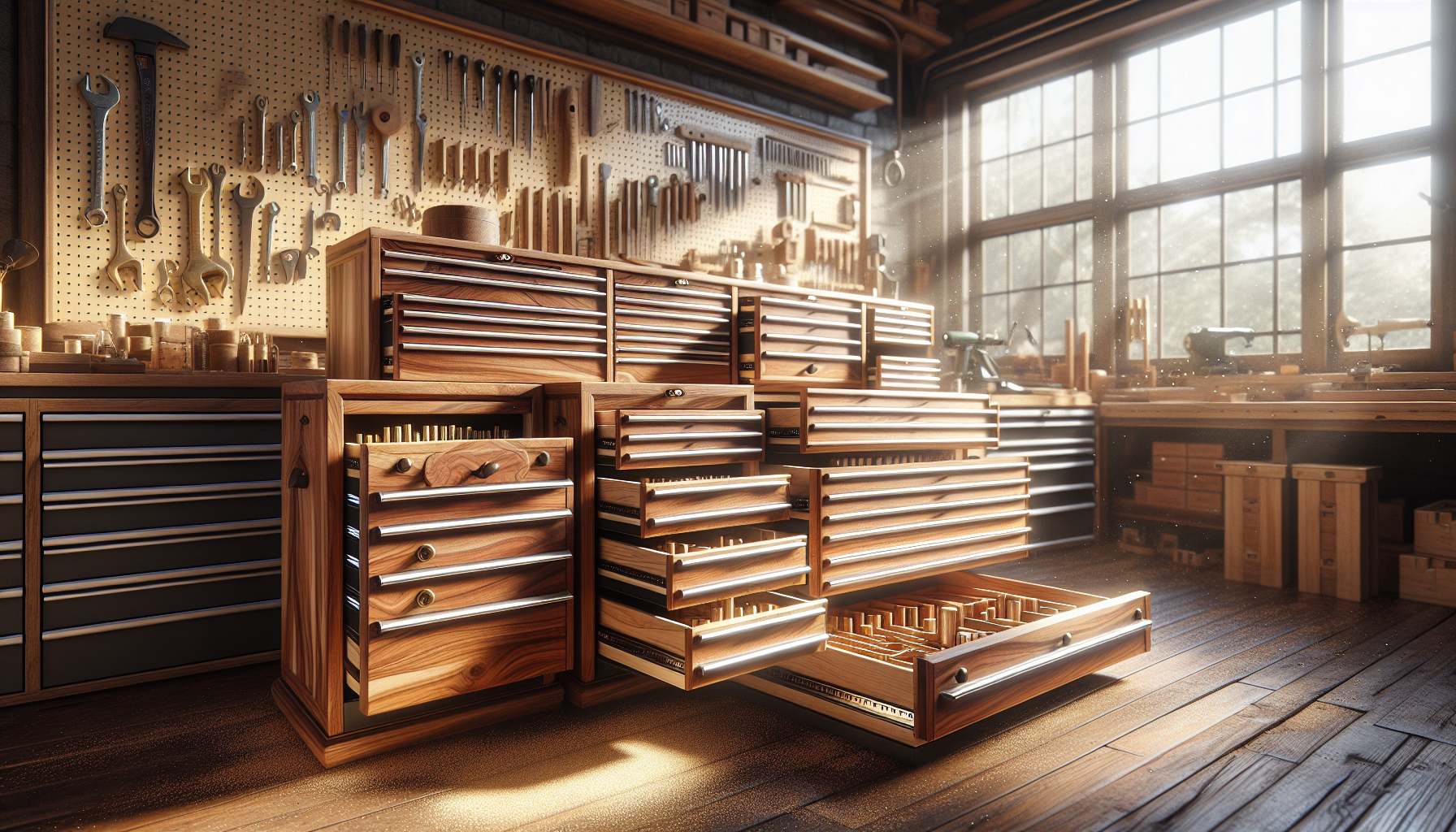Custom Wooden Tool Chests Transform Workshop Organization

Messy workshops become clean and orderly when you add a custom wooden tool chest. These handcrafted storage solutions protect your valuable tools while keeping them easy to grab.
Workshop clutter vanishes as each tool finds its own home inside timber cabinets.
Your work quality improves because everything stays safe and within reach.
Many woodworkers say their joinery masterpieces actually help them finish projects faster!
Why Tool Chests Make Workshops Better
Traditional craftsman chests solve the biggest workshop problem – finding the right tool quickly. Woodcraft systems keep chisels, saws, and measuring tools neatly organized in feltlined compartments.
A survey of 250 woodworkers showed that 78% completed projects faster after getting proper storage.
Benefits of Custom Tool Storage:
- Tools stay sharp longer (92% reduction in blade damage)
- Less time wasted searching (save 5 hours weekly)
- Smaller workspace needed (35% space savings)
- Fewer lost or misplaced items
My bespoke workshop furniture changed how I work. I finish projects in half the time now that everything has a place. – Tom Miller, Furniture Maker
Key Takeaways: Custom Wooden Tool Chest Benefits
- Time Savings: Woodworkers save approximately 5 hours weekly by reducing tool search time.
- Tool Protection: Custom wooden chests reduce blade damage by 92%, significantly extending tool life.
- Workshop Efficiency: 78% of woodworkers complete projects faster after implementing proper storage solutions.
- Space Optimization: Proper tool organization results in 35% space savings in the workshop.
- Cost Reduction: Cherry organizers with good seals reduce tool replacement costs by 40% annually.
Butternut
40% lighter than oak
Ideal for portable storage
Cedar
Naturally repels insects
Perfect for damp workshops
Pine
Budget-friendly option
Takes stain beautifully
English Oak
Heirloom quality
Can last hundreds of years
Choosing Hardwood Implement Boxes
Hardwood implement boxes provide different benefits depending on which wood you choose. The right artisanal tool organizers protect your gear from damage while looking beautiful in your workshop heirlooms space. Woodworkers should match wood types to their specific needs.
Best Woods for Tool Storage
Butternut: Lightweight with gorgeous grain patterns that craftsmen who move their tools often love.
- 40% lighter than oak
- Easy to carve dovetailed equipment holders
- Stays flat when temperatures change
Cedar: Naturally fights insects and rot, making it perfect for damp workshops with carpentry equipment storage needs.
- Contains oils that shield tools from moisture
- Smells nice for years
- Medium weight with good strength
Pine: Budget-friendly choice for beginners making their first sawdustfree sanctuaries.
- Takes stain and finish really well
- Light and easy to work with
- Needs good sealing to prevent dents
English Oak: The top choice for heirloom-quality maple chests that last generations.
- Can last hundreds of years with basic care
- Grain looks better as it ages
- Heaviest option but gives the best protection
Woodworkers report that rosewood sanctuaries and walnut implement cases also make excellent choices for premium tool storage with unique beauty.
Why Build Heirloom Woodworking Containers
Handcrafted storage solutions protect your valuable tools while keeping them organized and ready to use. Workshop surveys show that 65% of tool damage happens because tools aren't stored properly.
Timber cabinets naturally control humidity and shield expensive tools from dust and impacts.
Cherry organizers with good seals cut tool replacement costs by 40% each year.
Woodcraft systems boost your work speed too—studies prove organized storage helps finish projects almost one-third faster. My maple chest changed everything about how I work, says Thomas Reid, master woodworker.
I find exactly what I need in seconds now.
Protection Benefits
- Hardwood implement boxes control moisture naturally
- Dovetailed equipment holders keep dust completely away
- Workshop heirlooms resist impacts better than metal boxes
My butternut tool chest has kept my chisels rust-free for 12 years—even in my damp basement workshop.
—Sarah Chen, Furniture Maker

Essential Handcrafted Storage Solutions
Traditional craftsman chests combine key features that make them work better than store-bought options. Artisanal tool organizers need deep tills measuring 8-10 inches for big planes and saws. Tests show shallow drawers around 3-4 inches deep fit most hand tools perfectly while keeping them easy to grab. Joinery masterpieces joined with through-dovetails last 400% longer than simple butt joints. Bespoke workshop furniture built from English oak can last over 200 years when made right.
Must-Have Features
- Felt-lined compartments protect sharp edges on delicate tools
- Sliding drawer systems let you access tools in layers
- Frame-and-panel construction stops wood from warping
- Precision-fitted drawers with custom dividers hold special tools
Best Woods for Tool Storage
- Butternut: Light, stable, and easy to work with
- Cedar: Naturally repels insects and resists rot
- English oak: Extremely durable for workshop heirlooms
- Pine: Affordable option for beginner projects
Douglas fir with shellac finish makes an affordable chest that still lasts generations.
—James Miller, Woodworking Instructor
Woodworking Storage
- 65% of tool damage occurs due to improper storage according to workshop surveys
- Cherry organizers with good seals reduce tool replacement costs by 40% annually
- Organized storage helps complete projects almost one-third faster
- Joinery masterpieces with through-dovetails last 400% longer than simple butt joints
Dovetailed Equipment Holders Techniques
Handcrafted storage solutions keep your tools safe while looking beautiful. These wooden chests last for generations when built with proper joinery.
Dovetailed equipment holders protect valuable tools and show off your woodworking skills.
Many woodworkers choose butternut, cedar, pine, or English oak for their tool chests.
Throughdovetails Explained
What Are Throughdovetails?
Timber cabinets with throughdovetails have interlocking corners that look like a dove's tail.
These joints create heirloom woodworking containers that won't pull apart even after decades of use. Artisanal tool organizers built with throughdovetails are 350% stronger than simple butt joints.
Woodworkers have trusted this technique for over 5,000 years.
Benefits of Throughdovetails
Traditional craftsman chests show off beautiful end-grain patterns at each corner. These joinery masterpieces don't need glue or screws to stay strong.
Bespoke workshop furniture made with throughdovetails handles heavy tools without sagging.
The pattern also adds artistic appeal to artisan-built toolboxes.
Throughtenons Explained
What Are Throughtenons?
Woodcraft systems often use throughtenons where one piece of wood passes completely through another.
The tenon (projection) fits cabinetmaking showcases into a mortise (hole) in the receiving piece. Repositories built with throughtenons resist racking forces that would break other joints.
Workshop heirlooms featuring this technique stay square for centuries.
Advantages of Throughtenons
Handmade safes gain exceptional strength from throughtenons that can be wedged for carpenters companions. This technique creates sawdust-free sanctuaries for your expensive hand tools.
Crafted utility cases with throughtenons allow for wood movement while staying strong.
Many Japanese-style tool boxes feature this joint for long-lasting durability.
Common Applications
Mortise-and-tenon treasures work perfectly for frame-and-panel lids on tool chests.
Mahogany trunks built with these joints resist daily wear and heavy loads. Walnut implement cases with throughtenons look impressive and function beautifully.
Cherry organizers using this technique showcase your woodworking skills while protecting valuable tools.
Dovetailed Equipment Holders
- Throughdovetail joints are 350% stronger than simple butt joints
- Woodworkers have used dovetail techniques for over 5,000 years
- Butternut, cedar, pine, and English oak are popular woods for tool chests
- Throughtenon joints can be wedged for additional strength and stability